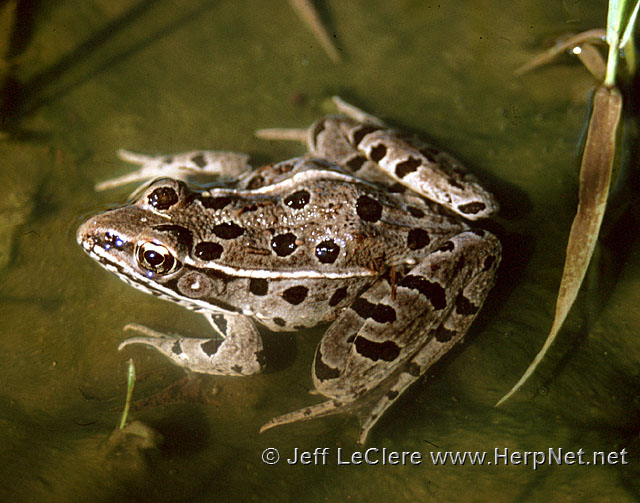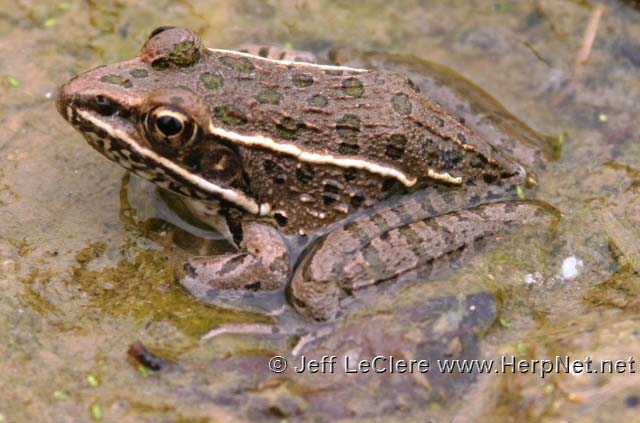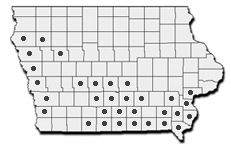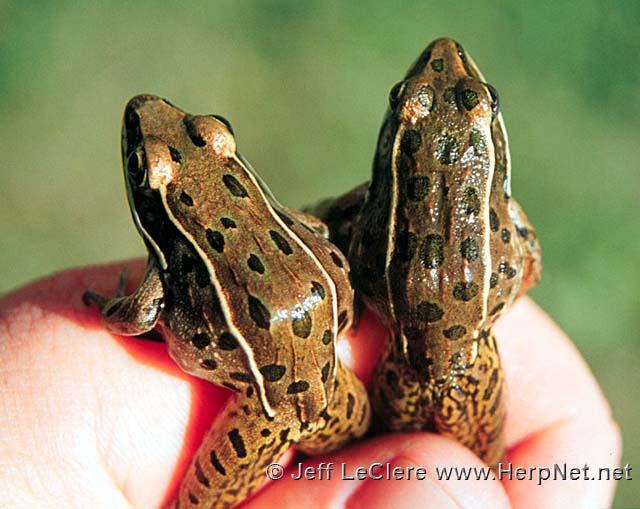Plains Leopard Frog (Lithobates blairi)
Alternate names: Rana blairi
by Jeff LeClere

Plains leopard frog, Lithobates blairi, calling.
Status
A valid fishing license is required to possess this species for bait or food. This frog is common in southern and western Iowa.
Description
The leopard frog is the most familiar frog in Iowa. They may grow to 3 1/2 inches body length. Plains leopard frogs are always brown or gray on top with round black spots scattered randomly about the back and on the sides and usually one on the snout. These spots have a light outline. The belly is plain white. There are two light (sometimes golden) incomplete dorsolateral ridges down the back. These ridges are continuous nearly to the groin. Here they break and the very short remainder of the ridges are inset. There are spots on the forelimbs and tiger stripes or bars on the hind legs. these are dark, sometimes even greenish. The groin and thighs have a greenish (very rarely yellowish) wash. They differ from pickerel frogs by having round spots scattered randomly about the about the back, and a greenish wash on the thighs. Also pickerel frogs are found only in the trout streams of extreme eastern Iowa.

Subspecies
There are no subspecies of the plains leopard frog, Lithobates blairi.
Range
The plains leopard frog is found in the southern half of Iowa, but they range north along the Missouri River to Plymouth County in western Iowa.

Habitat
The plains leopard frog is found in all water types. Lakes, ponds, rivers, streams, large and small wetlands, even homemade ponds. Leopard frogs move considerable distances from water, especially in wet grasslands or damp woodlands.

Habits
Plains leopard frogs breed in March and April. Sometimes males call while underwater. They produce a chuckling call. Their call lacks the long snore of the northern leopard frog. A single female may lay 3,000 to 5,000 eggs in a round mass. The females may all lay eggs in one portion of the pond. Tadpoles metamorphose in about three months. During rainy weather, (especially during spring or fall migrations) great numbers of these frogs are seen crossing the roadway, especially near wetlands. During the summer they may venture into backyards and move into outdoor ponds or swimming pools. When they move far from a body of water, they may absorb dew to keep them moist. They hibernate in deep water. Plains leopard frogs are one of the most common frogs in southern Iowa, however, these frogs are declining due to habitat destruction, additions of roadways, pollution, diseases, and other factors. Also, any medium or large sized carnivores prey upon them.
Food
Plains leopard frogs consume insects, earthworms, and other invertebrates.